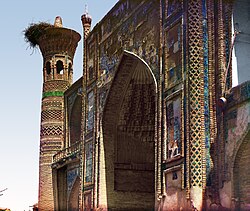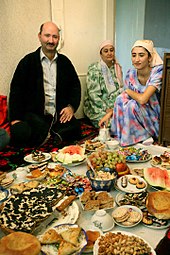
Central Asia is a subregion of Asia that stretches from the Caspian Sea in the southwest and Eastern Europe in the northwest to Western China and Mongolia in the east, and from Afghanistan and Iran in the south to Russia in the north. It includes Kazakhstan, Kyrgyzstan, Tajikistan, Turkmenistan, and Uzbekistan. The countries as a group are also colloquially referred to as the "-stans" as all have names ending with the Persian suffix "-stan" in both respective native languages and most other languages.

Tajikistan, officially the Republic of Tajikistan, is a landlocked country in Central Asia. Dushanbe is the capital and most populous city. Tajikistan is bordered by Afghanistan to the south, Uzbekistan to the west, Kyrgyzstan to the north, and China to the east. It is separated from Pakistan by Afghanistan's Wakhan Corridor.
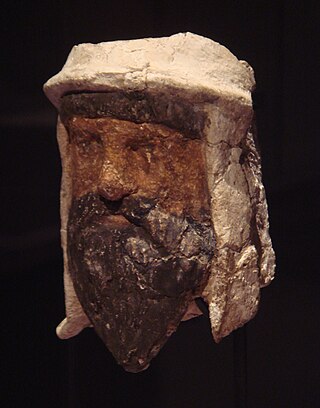
Tajikistan harkens to the Samanid Empire (819–999). The Tajik people came under Russian rule in the 1860s. The Basmachi revolt broke out in the wake of the Russian Revolution of 1917 and was quelled in the early 1920s during the Russian Civil War. In 1924, Tajikistan became an Autonomous Soviet Socialist Republic of the Soviet Union, the Tajik ASSR, within Uzbekistan. In 1929, Tajikistan was made one of the component republics of the Soviet Union – Tajik Soviet Socialist Republic – and it kept that status until gaining independence 1991 after the dissolution of the Soviet Union.

Uzbekistan is a landlocked country in Central Asia. It is itself surrounded by five landlocked countries: Kazakhstan to the north; Kyrgyzstan to the northeast; Tajikistan to the southeast; Afghanistan to the south, Turkmenistan to the south-west. Its capital and largest city is Tashkent. Uzbekistan is part of the Turkic languages world, as well as a member of the Organization of Turkic States. While the Uzbek language is the majority spoken language in Uzbekistan, Russian is widely used as an inter-ethnic tongue and in government. Islam is the majority religion in Uzbekistan, most Uzbeks being non-denominational Muslims. In ancient times it largely overlapped with the region known as Sogdia, and also with Bactria.

Tajiks are a Persian-speaking Iranian ethnic group native to Central Asia, living primarily in Afghanistan, Tajikistan, and Uzbekistan. Tajiks are the largest ethnicity in Tajikistan, and the second-largest in Afghanistan and Uzbekistan. They speak varieties of Persian, a Western Iranian language. In Tajikistan, since the 1939 Soviet census, its small Pamiri and Yaghnobi ethnic groups are included as Tajiks. In China, the term is used to refer to its Pamiri ethnic groups, the Tajiks of Xinjiang, who speak the Eastern Iranian Pamiri languages. In Afghanistan, the Pamiris are counted as a separate ethnic group.

Khujand, sometimes spelled Khodjent or Chudzjand, and known as Leninabad from 1936 to 1991, is the second-largest city of Tajikistan and the capital of Tajikistan's northernmost Sughd province.

Islam is the largest religion practiced in Kazakhstan, with estimates of about 74% of the country's population being Muslim. Ethnic Kazakhs are predominantly Sunni Muslims of the Hanafi school. There are also small numbers of Shias. Geographically speaking, Kazakhstan is the northernmost Muslim-majority country in the world, and the largest in terms of land area. Kazakhs make up over half of the total population, and other ethnic groups of Muslim background include Uzbeks, Uyghurs and Tatars. Islam first arrived on the southern edges of the region in the 8th century from Arabs. According to the Constitution, The Republic of Kazakhstan proclaims itself as a democratic, secular, legal and social state whose highest values are a person, his life, rights, and freedoms.

Russian Turkestan was the western part of Turkestan within the Russian Empire’s Central Asian territories, and was administered as a Krai or Governor-Generalship. It comprised the oasis region to the south of the Kazakh Steppe, but not the protectorates of the Emirate of Bukhara and the Khanate of Khiva. It was populated by speakers of Russian, Uzbek, Kazakh, Kyrgyz, and Tajik.

Sunni Islam is, by far, the most widely practiced religion in Tajikistan. Sunni Islam of the Hanafi school is the recognized religious tradition of Tajikistan since 2009. According to a 2009 U.S. State Department release, the population of Tajikistan is 98% Muslim,, with some Sufi orders.

Central Asia has long been a geostrategic location because of its proximity to the interests of several great powers and regional powers.

The Tajikistani Civil War, also known as the Tajik Civil War, began in May 1992 and ended in June 1997. Regional groups from the Garm and Gorno-Badakhshan regions of Tajikistan rose up against the newly-formed government of President Rahmon Nabiyev, which was dominated by people from the Khujand and Kulob regions. The rebel groups were led by a combination of liberal democratic reformers and Islamists, who would later organize under the banner of the United Tajik Opposition. The government was supported by Russian military and border guards.

National delimitation in the Union of Soviet Socialist Republics was the process of specifying well-defined national territorial units from the ethnic diversity of the Union of Soviet Socialist Republics (USSR) and its subregions.

Soviet Central Asia was the part of Central Asia administered by the Soviet Union between 1918 and 1991, when the Central Asian republics declared independence. It is nearly synonymous with Russian Turkestan in the Russian Empire. Soviet Central Asia went through many territorial divisions before the current borders were created in the 1920s and 1930s.

After it was established on most of the territory of the Russian Empire, the Soviet Union remained the world's largest country until it collapsed in 1991. It covered a large part of Eastern Europe while also spanning the entirety of the Caucasus, Central Asia, and Northern Asia. During this time, Islam was the country's second-largest religion; 90% of Muslims in the Soviet Union were adherents of Sunni Islam, with only around 10% adhering to Shia Islam. Excluding the Azerbaijan SSR, which had a Shia-majority population, all of the Muslim-majority Union Republics had Sunni-majority populations. In total, six Union Republics had Muslim-majority populations: the Azerbaijan SSR, the Kazakh SSR, the Kyrgyz SSR, the Tajik SSR, the Turkmen SSR, and the Uzbek SSR. There was also a large Muslim population across Volga–Ural and in the northern Caucasian regions of the Russian SFSR. Across Siberia, Muslims accounted for a significant proportion of the population, predominantly through the presence of Tatars. Many autonomous republics like the Karakalpak ASSR, the Chechen-Ingush ASSR, the Bashkir ASSR and others also had Muslim majorities.

Islam is the predominant religion in Tajikistan.

The Spiritual Administration of the Muslims of Central Asia and Kazakhstan (SADUM) (Russian: Духовное управление мусульман Средней Азии и Казахстана (САДУМ); Uzbek: Ўрта Осиё ва Қозоғистон мусулмонлари диний бошқармаси) was the official governing body for Islamic activities in the five Central Asian republics of the Soviet Union. Under strict state control, SADUM was charged with training clergy and publishing spiritual materials, among other tasks. The organization was headquartered in Tashkent, Uzbekistan. Established in 1943, SADUM existed for nearly 50 years. With the dissolution of the Soviet Union, the five newly independent republics reformed their respective branches of SADUM into their own national Islamic institutions.
A muftiate is an administrative territorial entity, mainly in the post-Soviet and Southeast European states, under the supervision of a mufti. In the post-Yugoslavia states, spiritual administrations similar to the muftiate are called riyasat.
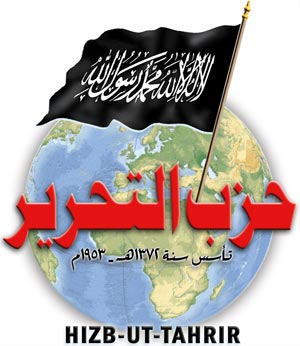
Hizb ut-Tahrir is a pan-Islamist and fundamentalist group seeking to re-establish "the Islamic Khilafah (Caliphate)" as an Islamic "superstate" where Muslim-majority countries are unified and ruled under Islamic Shariah law, and which eventually expands globally to include non-Muslim states. In Central Asia, the party has expanded since the breakup of the Soviet Union in the early 1990s from a small group to "one of the most powerful organizations" operating in Central Asia. The region itself has been called "the primary battleground" for the party. Uzbekistan is "the hub" of Hizb ut-Tahrir's activities in Central Asia, while its "headquarters" is now reportedly in Kyrgyzstan.
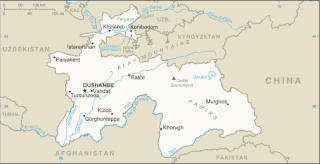
The Tajikistan–Uzbekistan border is an international border between Tajikistan and Uzbekistan. It is 1,312 kilometres (815 mi) in length and runs from the tripoint with Kyrgyzstan to the tripoint with Afghanistan.

This is a select bibliography of English language books and journal articles about the history of Central Asia. A brief selection of English translations of primary sources is included. Book entries have references to journal articles and reviews about them when helpful. Additional bibliographies can be found in many of the book-length works listed below; see Further reading for several book and chapter-length bibliographies.
